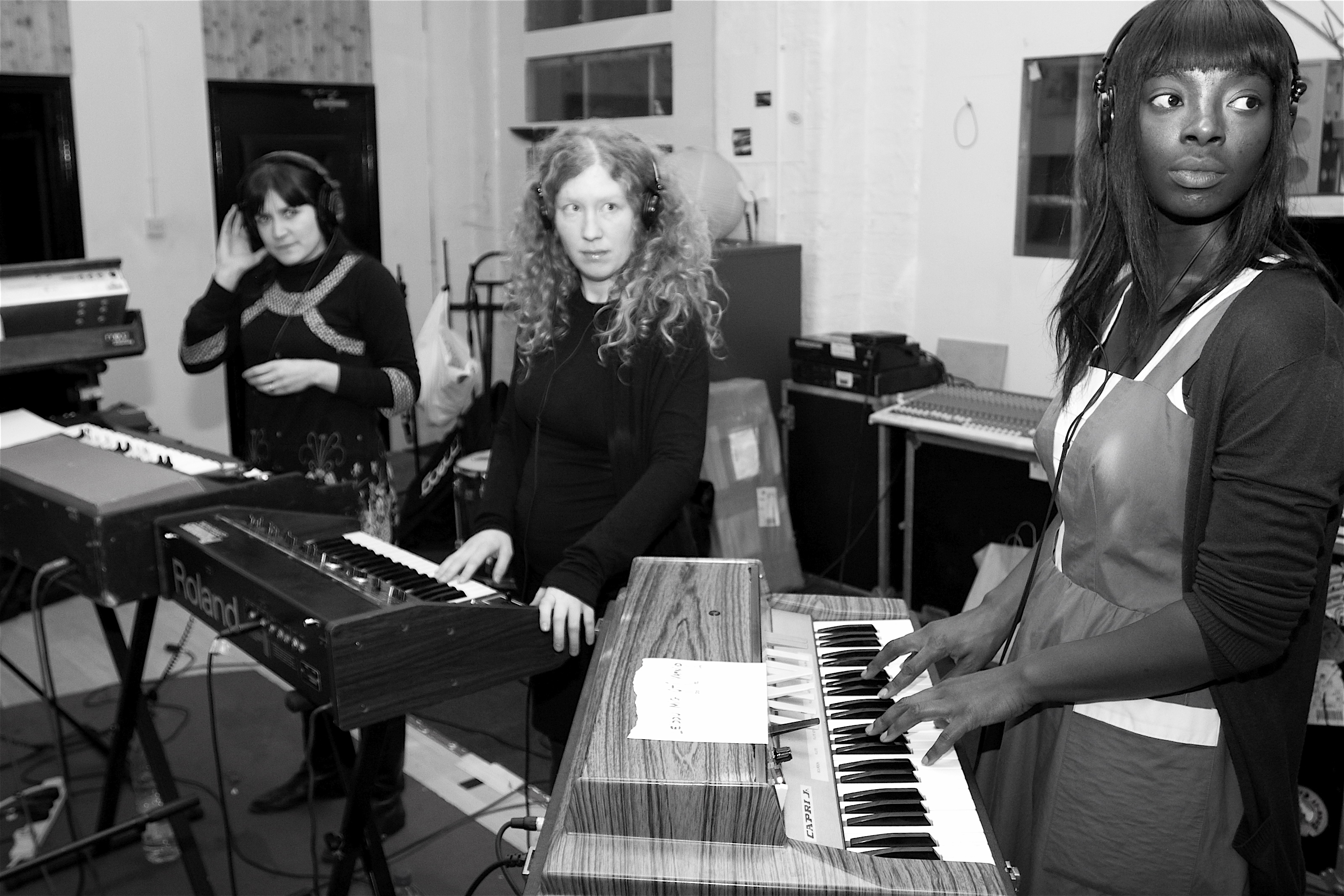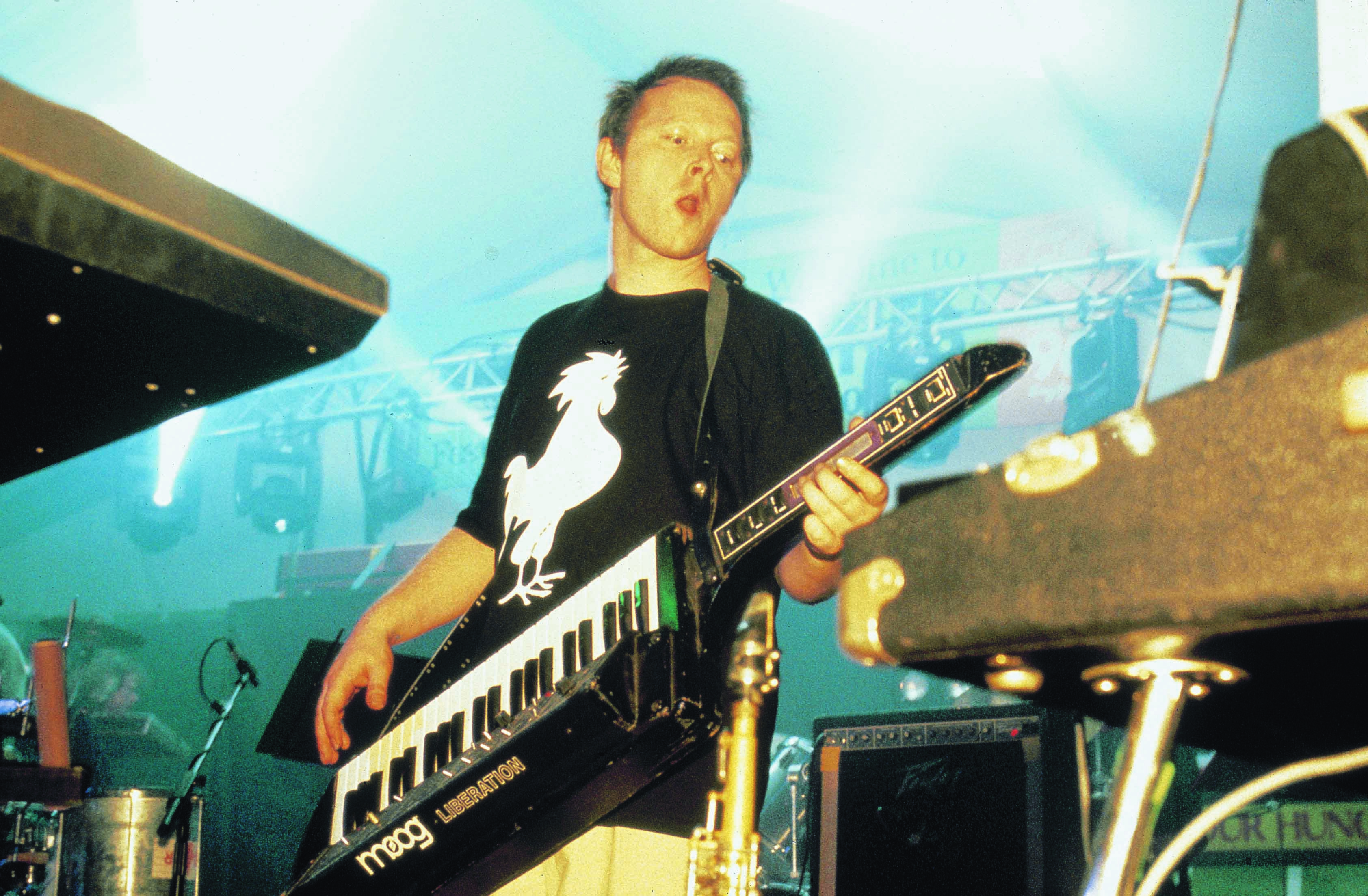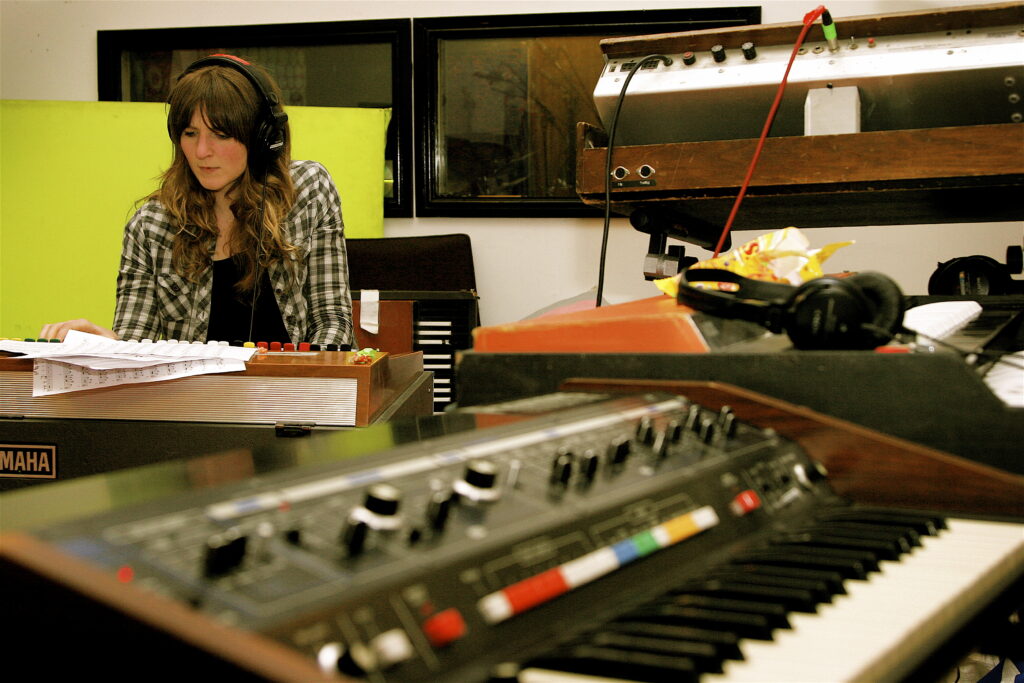As a teenager growing up in the prog rock era of 70s in a darkened room with headphones you were never short of mystery keyboard sounds.
I would read the back of the LP sleeves and try to imagine some of the strange instruments listed such as VCS3, RMI, Moog Bass, ARP2600 and The Mellotron.
I began even to recognize the jerky orchestral tones of a Mellotron, always visibly distinctive on stage as a white kitchen cabinet of a keyboard. John Paul Jones had one on the Led Zep Poster on my bedroom wall. Rick Wakeman had two to rest his Minimoogs on. The word Moog originally covered anything I couldn’t identify, because I believed these new "Synthesizers" to be chameleon like and therefore possessing the ability to sound like anything.
I later found out that this was not true. A Moog sounds uniquely like a Moog and an ARP Odyssey sounds more like a Moog coming out of a fairy liquid bottle. It was more of a citrus sound to the Moog’s full flesh mango goo. A Fender Rhodes Piano had that ubiquitous mellow thuddy chime – the sound of Galaxy chocolate. This was supported by Stevie Wonder who said it had a "brown sound" (he sees sounds as colors). He used all of these sounds on his 70s albums Talking Book, Innervisions and Fulfillingness’ First Finale. I bought these from my local Woolworths on the day of release, because I was getting obsessed. Stevie had it all going on…
There was that weird clucking harpsichordy twangy keyboard he used. The Clavinet – the superbad keyboard of the superbad 70s. Even the caberet band at the Pontins I had my holidays at had one. It too looked like a sticky back plastic covered kitchen unit with picnic table legs.
On the TV I would get perplexed as to why Richard Carpenter’s electric piano didn’t quite have a Fender Rhodes sound like that “Supertramp “sound, which turned out to be a Wurlitzer electric piano – less thick with a reedy twang. Roxy Music had some unrecognizable keyboards including an attaché case covered in knobs with colored pins and a joystick. It would crop up again in Pink Floyd’s Live at Pompeii for which we R.A.F. great coat wearing, Afghan stinking joss stick wielding types was compulsory viewing. Rick Wright had a number of organs and contraptions for making his spooky soundscapes, all delightfully laid out on a runway on the back of the Umma Gumma LP.
The suitcase synth turned up at all sorts of gigs I went to see from Gong to Earth Wind and Fire. Larry Dunn, EWF’s keyboard player had a huge rig (this being the collective term for a bunch of keyboards on stage) with running lights and all kinds of synthesizers, organs, a Rhodes, a clavinet and even a synth that talked (a Vocoder).
Hawkwind also had this burbling attaché case, (which was finally identified as a EMS VCS3, or to be precise: a synthi A or the mark2 VCS)but in ’75 they seemed to be maturing with the inclusion of the grown up sounds of The Mellotron. Pseudo orchestral tones just didn’t suit the ‘Wind. Instead they belonged with Yes, Genesis and the best exploiter of the ‘Tron, King Crimson.
I tried to get into E.L.P.
Emerson had a ridiculous rig that included a Giant Moog Modular synthesizer with a TV in it, a couple smaller Mini Moogs on top of his Hammond C3 and even a spare organ to hurl around on stage. I made tapes of just the Moog freak out bits. Friends at school lent me Journey to the Centre of the Earth and 6 Wives by Rick Wakeman. They were worth it for the rig shots on the gatefolds. Other good rigs were spotted on Tomita albums and were duly taped off trendy parents’ hi-fis. ”Tape over taped over tapes of Tomita.” Two groups I really liked for their synth sounds were Mahavishnu Orchestra and Weather Report. Mahavishnu were a Moog band and Weather Report were an ARP band.

Jan Hammer broke a lot of new ground by approaching the Moog through an interest in the vina and Indian classical music, a good place to study pitch bending. He got deep in with the Moog’s details. It sang and probed. He developed his own voice on the instrument. You could spot him a mile away. The same with Zawinul from Weather Report.
Joe Zawinul is my all time synth hero.
He wrote the book as a colourist and had an uncanny ability to play lines that bubbled up joyously through his phrasing and little nuances that only this new instrument could deliver. In his hands the synth became a very credible instrument. You’ve got to remember back in the mid 70s – these new colors and shapes were rad! (I know you’re all thinking about Miami Vice and Birdland but there was a lot more to these pioneers.)
Synths defined the era to me. I made up my mind then that I would have to have to get me one of these synthesizers but they cost thousands of pounds. Totally unobtainable.
In 1976 a friend from school got his mum to drop us off at a warehouse near Old Trafford in Manchester (it’s now my local B&Q but then it was The Hardrock). A German synth trio had come to visit us called Tangerine Dream. They were promoting their new LP Rubicon. I’d never seen so many keyboards and synths gathered in one place. The image became imprinted on my mind. I was sketching it for the next 6 months in the back of my exercise books, designing new Rigs and even getting my Dad to help me make some new cabinets for a Tone generator he’d brought back from work. I also made a fake Mellotron from a Woolworth’s chord organ and my synth was a Rolf Harris stylophone.
I obtained an electric violin for £12 from an advert on the notice board of Virgin Records. Someone had filled an old violin with roofing insulation, fitted a contact mic and painted it dulux white. It looked pretty cool with a curly lead coming out of it. Again my dad had brought more electronics from work: a huge public address amplifier (decommissioned from the McVities Biscuit factory) to plug my violin into. It had a map of the world in glass which I could dial through longwave radio on and a huge gymkhana type horn speaker.
It was pure parent torture as I tried to keep up with the Mahavishnu and Zappa records especially with the all-important wah wah pedal.
I was soon in a band with the Black Sabbath fan in year 4. Just as Punk blew up. This left us with an identity crisis. No electric violins and keyboards were needed. Well not for a few months at least. Everyone started hacking their own haircuts and narrowing their jeans.

Ten years later on in 1987 I was beginning to make a small amount of cash just as everyone is replacing their out of date keyboards with a Yamaha DX7, the new 1980s wonder synth that had Midi capability. (A system were one Master keyboard could play other keyboards via a special cable.) The DX7 could sound like a Rhodes. It could sound like a Moog. It could sound like a Mellotron but it only weighed 15 pounds. One day in 1988 at Johnny Roadhouse (music junk shop in MCR) I spent £150 and walked out with a Moog Prodigy, a Moog Rogue, an ARP string synth, a clavinet C, a Pro One synth and just for good measure a Vox Jaguar Combo Organ.
Some of which really fitted into our then new acid house project 808 State. At the time it was a couple of drum machines and some small synths that we carried round in one of those old ladies tartan shopping trolleys.
On the wall of 808 State’s Studio we had a blow-up photocopy of Herbie Hancock’s rig from the back of his album Sunlight. I was gradually recreating that rig as we entered the 90s. We were lucky to ride in the first wave of UK rave and consequently found our selves playing some huge shows. Our presentation was basically shaping-up into a Emerson-esque keyboard rig or two. I didn’t really need a Rhodes or a clavinet or an Arp String Synth to do rave. Just one finger a Casio and a fist in the air. But I did have them. I was carrying out the “cockpit” tradition. Whilst out raving we would jealously eye up other group’s rigs, Orbital, The Prodigy, KLF (big on Oberhiem Synths the KLF). There was an element of display in the 1st generation of UK rave. Probably because we had to figure out how to present it as a show. To hide behind a lot of equipment and point strobes and lazers at the audience seemed to be the blueprint at that time as the spirit of communion was prevalent, the audience wasn’t nessesarily looking at the stage.
You could go off to the toilet and no one would notice.
During my time with 808 State during the 90s we could trawl pawn shops on a US tour and you’d get a fairly good batch of old keyboards. 808 State also had synthesizer ‘agent’; a guy we called Captain Techno. He was a pilot for Monarch Airways who flew out of MCR Airport and was a synth collector/repairman.
Captain Techno would turn up from trips to Canada with all sorts of booty in his estate car and we might get lucky with something rare like a Prophet T8 Synth or the rare Rhodes Chroma. Luckily we lived nearer the airport than Vince Clarke one of his other clients so we often got first pick.
During the 90s we worked a lot in Sheffield’s FON Studio. Sheffield was a good source of old prog keyboards and next door to us was the inspiring collection that belonged to The Human League.
We realized we were not alone in our nerdy pursuit of forgotten tech, but considering we had the same tools we were from two different cultures. In fact the 90s brought on a reassessment of how circuit boards were so much more musical than microchips. And we reassesed early synth pop in the process.
Moogs and Rolands ruled again and the second hand market took off as new ways were worked out to fasten the old analogue keyboards up to your Atari computer.
The most insane keyboard collection I’d ever seen belonged to Richard ‘Aphex Twin’ James. He had a whole building that was rammed to the gills with esoteric synthesisiers. He even had the famed VCS8 and the behemoth Yamaha GX1. So few were made you can trace each one back to a 70s super group (his being Hot Chocolate’s).
Where was he getting them all from? E Bay. E Bay scared me
I started to hover and look at it intermittently. A new term came into use, "gear porn". Well, we can just look at it, we don’t need to buy it.
In 1997 Some of my musical friends started a new monthly band in Manchester called TOOLSHED, mainly to start using my gear collection outside the confines of Techno and giving some of my more obscure keyboards a good airing. Most of our musicians drew inspiration from a huge stack of Sun Ra recordings that featured early keyboard technology such as clavinets, Roksichords, Tiger organs and Claviolines, alongside his multiple drummers and wind players.
TOOLSHED was an orchestra of multi-instrumentalists let loose in a pawnshop. I had also been taking up the keyboard role in another group in Manchester, HOMELIFE, where I was required to play the Farfisa organ. I fell in love with this cheesy little garage organ, it vibrated under your fingers and spat out rude noise. I picked up another small organ, a Wem Teisco C a lovely bit of retro furniture.
This one nearly blew my arm off with its bad 1960s wiring but when my Dad got at it with a soldering iron, it revealed itself to be a source of sounds from my childhood that touched a nerve.
Way back in the 60s my brothers and I took weekly turns to buy one 7" single a week. One of the first ones I bought had four cover versions of hits of the day featuring ‘Atlantis’ and ‘Ice Cream Man’. Both had this special organ sound trying to sound like string sections with ridiculous vibrato and reverb . Later on when I was given Joe Meek records I realized ‘Ice Cream Man’ was a Meek instrumental. I liked instrumentals as a kid, I loved The Shadows, they always played them at the cinema whilst waiting for the films. The cinema sound system was one of the few places where you could feel bass back then. It didn’t really come out of a small Dansette record player or the TV. The Shadows sounded like the big wide world to me really glamorous. I loved the track ‘Atlantis’ and its misty organ. This instrument seemed to be in every Gerry Anderson TV show from Fireball XL5 to UFO. There was always a cheesy combo organ that stated: ‘This is Space Age.’ One of my dad’s friends had an electric organ back in the 60s that we used to get to play space music on.
An object of great mystery with its horseshoe lay-out of coloured tabs and lights. Set it to max vibrato, max reverb, otherworldly sounds! Everyone queued up to have go at being Doctor Phibes by playing all the notes at once and pressing colored tabs. I found a resonance of this later on in my favorite organist ever, Larry Young. His work with The Tony Williams Lifetime has obvious jazz chops mixed with just textured horror peeling paint noise. He’s often called the Hendrix of the Hammond, which is confusing if you come in through his Blue Note jazz recordings where he is as mid 60s as Scandinavian furniture.
By the late 60s he s certainly on the same medication as Hendrix. By The 70s Young has gone all funk and writes the classic ‘Turn Out The Lights’ which shows you what he can do with a Moog. He died soon after.

By 2001 I was in love with this WEM organ which went when the rehearsal room got robbed. I just had to find another.. I put in a search on E bay. Oh damn there’s a really nice Yamaha YC45D organ. The YC45D brings up all kinds of good associations with me. Miles Davis’s Agarta/Pangaea phase. Magma’s Kohntakos, Santana’s Welcome/Lotus albums. I’ll just buy this one… Oh shit I’ve won and it weighs how much? It’s in Germany? How much is the postage? Jesus!
When it arrived it was fantastic, sounding like Ron and Val Taylor underwater music, glassy and shimmering, pure or fuzzy with the ‘Crazy Horses’ felt strip bender thingy. I kept looking for the WEM though. "Damn check this Russian one
it looks like Yuri Gagarin’s dashboard… and so cheap… click… oops!
The purchase of a cute red organ which looks like Steve Zodiak’s sideboard in a the B & Q car park lead me to meet a man with a WEM who only wanted £60 for it. Bang! In the back of the net… At the same time someone else dug his Vox Continental out of his mum’s cellar to give to me. The Vox looks well cool with the reverse colour keys and dirty orange tolex finish. I could just look at it for hours.
I couldn’t use them all at once though. Well, I could have built some freak Wakeman style rig… And that’s where it began to form in my practise room.
An old friend Mandy Wigby brought her Elka X50 round for me to check out. She’d bought it off Dave Formula a few years previously. Dave was the keyboardist in Magazine. They were epic, important and overlooked. Dave painted their music with echoes of John Barry glamour using ARP synths and the Yamaha YC45D organ.
Right then! "What shall we do with all these E bay Fizz machines? We need some keyboard skills!" Mandy volunteered herself and her freind Naomi who teaches piano in a local secondary school. Next door’s piano teacher Ragna and her friend Henrietta all agree to commit to Tuesday afternoons
for a bit of Organry. By this point however I’d gotten quite interested in playing my son’s drum kit.
Gallons of Tea and tons of cakes later we became THE SISTERS
OF TRANSISTORS. The UK’s Premier Ladies Combo Organ Quartet.




